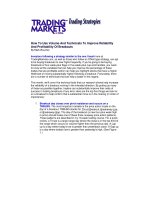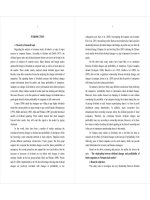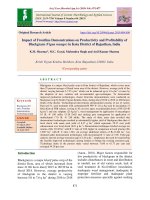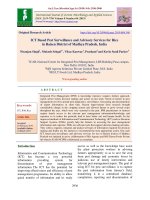Cost, returns and profitability of Kharif maize in Solapur district of Maharashtra, India
Bạn đang xem bản rút gọn của tài liệu. Xem và tải ngay bản đầy đủ của tài liệu tại đây (170.31 KB, 5 trang )
Int.J.Curr.Microbiol.App.Sci (2019) 8(5): 1845-1849
International Journal of Current Microbiology and Applied Sciences
ISSN: 2319-7706 Volume 8 Number 05 (2019)
Journal homepage:
Original Research Article
/>
Cost, Returns and Profitability of Kharif Maize in
Solapur District of Maharashtra, India
A.B. Jain, R.D. Shelke* and D.U. Meshram
Department of Agricultural Economics, College of Agriculture, Latur, India
*Corresponding author
ABSTRACT
Keywords
Maize, Cost, Gross
return, Net profit
and B:C ratio
Article Info
Accepted:
15 April 2019
Available Online:
10 May 2019
Maize (Zea maize) belongs to family (Gramineae). It is the third most important cereal
food grain crop in the world followed by rice and wheat. The origin of maize is Mexico in
Central America. It contributes about 20 per cent world’s total cereal production. For
present study multistage sampling design was used in selection of district, tehsils, and
village and maize growers. On the basis of high area under maize crop Malshiras,
Pandharpur and Sangola tehsils were selected. From selected three tehsils 6 villages were
selected purposely on the basis of highest area under maize crop. From each village 15
maize growers were selected. In this way 90 maize growers were selected for the present
study. The information collected with respect to expenditures and returns were analyzed in
tabular form by using cost concept like Cost –A, Cost- B and Cost – C. Data pertain to the
year 2017-2018 The result revealed that Cost – A was Rs.49631.66 in which share of Cost
–B was Rs.65483.72 while that of Cost – C was Rs.71276.94. Gross return was found to
be Rs.92475.42 and net profit was Rs.21198.48. The B:C ratio was 1.29.
Introduction
Maize is a major source of cooking oil (corn
oil) and of maize gluten. Maize starch can be
hydrolyzed and enzymatically treated to
produce syrups, particularly high fructose
corn syrup, a sweetener; and also fermented
and distilled to produce grain alcohol. Grain
alcohol from maize is traditionally the source
of bourbon whiskey. Maize is sometimes used
as the starch source for beer. It is also
nutritive for adults of different ages.
The green straw is suitable for making silage.
Maize is also used as the fodder for livestock.
The 100 grams of maize grains contains
carbohydrate 71-72 kcal, sugars 2-3 grams,
dietary fibers 9-10 grams, fats 4-45 grams and
proteins 9-10 grams minerals 1-4 grams
(Source: Agmarknet). The nutrients are very
important for the smooth functioning of the
body. It is a rich source of carbohydrates,
besides this, it provides essential body
building substances such as minerals and
proteins. It is also a rich source of water
(75.96 grams). Maize is consumed by the
people in India in many forms, it can be
consumed as a rotis or breads, in the forms of
pop corns or a pop grains. Besides this, maize
is used in preparation of starch, syrup,
1845
Int.J.Curr.Microbiol.App.Sci (2019) 8(5): 1845-1849
glucose, paper adhesive, acetic acid and lactic
acids, etc., the demand for which is increasing
day-by-day.
The Maharashtra is leading state as far as area
under the maize cultivation is considered
followed by Rajasthan and Karnataka. But in
the case of production and productivity, it
lags behind in the list. The average yield of
maize in Maharashtra is higher than the all
India average. In 2017-18, the area under
maize crop is 1097 (000 ha) with production
3450.4 (000 tonnes) and productivity was
3143 (Kg/ha) (Source: Krishi.maharashtra.
gov.in). The area under kharif maize in 201718 is 913.8 (000 ha) with production 2977.2
(000 tonnes) and productivity was 3248
(Kg/ha) (Source: Krishi.maharashtra.gov.in).
To identify the costs, returns and profitability
in maize production.
Materials and Methods
Multistage sampling design was adopted for
selection of the district, telsil, village and
paddy growers. In first stage, Solapur district
was purposively selected on the basis of
highest area under maize crop. In the second
stage, Malshiras, Pandharpur and Sangola
tehsils were selected on the basis of highest
area under maize crop. In the third stage, 6
villages were selected from each selected
tehsils.
In the fourth stage, from each of the selected
villages, 15 maize growers were randomly
selected. In this way 90 maize growers were
selected for the present study. Data were
collected with the help of presented schedule
by personal interview method for the year
2017-2018. Data were converted to per
hectare basis in tabular form; statistical tools
like arithmetic mean, percentage and ratio
were used for accounting the cost and returns
in maize production.
The cost concept like Cost –A, Cost –B, and
Cost –C were used for cost evaluation and to
estimate profitability in maize production.
Cost - A include the item namely, hired
human labour, bullock labour, machine
labour, seed, fertilizer, plant protection,
irrigation, land revenue, incidental charges,
interest on working capital and depreciation
on assets. Cost-B comprises of the cost-A plus
rental value of land and interest on fixed
capital. Cost-C includes the cost-B plus
family labour cost. The terms and concepts
used in present study were as fallows. Interest
on working capital included by charging
interest at the rate of 13 per cent items of
expenditure as hired human labour, bullock
labour, machine labour, seed, fertilizers,
manures, plant protection, land revenue an
incidental charges for crop duration.
Depreciation is the decrease in the value of
asset and 10 per cent on the present value at
the beginning of the year of farm implements
and machinery was taken and only the
proportionate charges were taken for the
estimate as 1/6th the value of gross produce
that is value of main product plus value of by
product minus land revenue. Interest on fixed
capital by charging interest at the rate of 11
per cent on investment on commonly used
assets like wooden implements, iron
implements which were distributed on
cropped area.
Results and Discussion
Per hectare physical inputs used and
output obtained in maize production
Per hectare physical inputs and outputs of
maize production were calculated and
presented in Table 1. It was observed that, the
use of hired human labour was 31.14, family
human labour was 18.99 man days and use of
bullock labour was 11.1 pair days in maize
farm. On the contrary, use of machine labour
was 13.01 hours/ha. The use of seed was
1846
Int.J.Curr.Microbiol.App.Sci (2019) 8(5): 1845-1849
17.44 kg/ha in maize farm. In regard to
manure, the quantity of 2.97 quintals/ha was
used in maize farm. Use of nitrogen,
phosphorous and potash was 72.77, 41.10 and
26.90 kg/ha, respectively in maize farm. Use
of plant protection was 9.57 litre. Use of
irrigation was 3466.67 cubic meters/ha in
maize farm. It was also observed from the
Table 1 that, main produce of maize was
37.47 quintals/ha and by produce was 2.63
quintals/ha.
Per hectare cost of cultivation of maize
Per hectare cost of cultivation of maize were
calculated and presented in Table 2. The
result revealed that, the per hectare cost of
cultivation was Rs.49631.66 in which Cost-A
consist 69.58 per cent, Cost-B, 91.81 per cent
and cost-C is 100 per cent i.e. Rs.65483.72,
and Rs.71276.94 respectively. Expenditure on
machine labour was Rs.19847.46 i.e. 27.84
per cent. Next item of expenditure is rental
value of land i.e. Rs. 14770.98 (20.72 per
cent), hired human labour accounted,
Rs.11877.12 (16.66 per cent), seed
Rs.6652.54 (9.33 per cent), family human
labour Rs.5793.22 (8.12 per cent), interest on
working capital Rs.2488.48 (3.49 per cent),
phosphorus Rs.1579.47 (2.21 per cent),
manure accounted, Rs.1472.03 (2.06 per
cent), bullock labour Rs.1185.54 (1.66 per
cent), interest on fixed capital Rs. 1081.08
(1.51 per cent), irrigation accounted, Rs.1000
(1.40 per cent), depreciation on farm assets
Rs. 956.23 (1.34 per cent), nitrogen Rs.948.92
(1.33 per cent), potash Rs.309.78 (0.94 per
cent), incidental charges Rs. 491.59 (0.68 per
cent), plant protection Rs.309.78 (0.43 per
cent) and land revenue Rs.150 (0.21 per cent)
respectively.
Table.1 Per hectare use of physical input and output in maize production (Unit/ha)
Sr. No Particulars
INPUT
1.
Hired human labour
2.
Family human labour
3.
4.
5.
6.
7.
8.
Bullock labour
Machine labour
Seed
Manure
Fertilizer
N
P
K
Plant protection
9.
Irrigation
Unit
Maize farm
man day
man day
31.14
18.99
pair day
hour
Kg
qtl
11.1
13.01
17.44
2.97
Kg
Kg
Kg
liter
72.77
41.10
26.90
9.57
3466.67
OUTPUT
10.
Main produce
11.
By-produce
qtl.
qtl.
1847
37.47
2.63
Int.J.Curr.Microbiol.App.Sci (2019) 8(5): 1845-1849
Table.2 Per hectare cost of cultivation of maize production
Sr. No Particulars
1.
Hired human labour
2.
Bullock labour
3.
Machine labour
4.
Seed
5.
Manure
6.
Fertilizer
7.
N
8.
P
9.
K
10.
Plant protection
11.
Irrigation
12.
Land revenue
13.
Incidental charges
14.
Interest on working capital @ 13%
15.
Depreciation on capital assets@10%
16.
Cost A (1-15)
17.
Rental value of land
18.
Interest on fixed capital @ 11%
19.
Cost B (16-18)
20.
Family human labour
21.
Cost C (19-20)
Unit
man day
pair day
Hour
Kg
qtl.
Kg
Ltr
m3
man day
-
Quantity
31.14
11.1
13.01
17.44
2.97
Amount
11877.12
1185.54
19847.46
6652.54
1472.03
Per cent
16.66
1.66
27.84
9.33
2.06
72.77
41.10
26.90
9.57
3466.67
18.99
-
948.92
1579.47
672.5
309.78
1000
150
491.59
2488.48
956.23
49631.66
14770.98
1081.08
65483.72
5793.22
71276.94
1.33
2.21
0.94
0.43
1.40
0.21
0.68
3.49
1.34
69.58
20.72
1.51
91.81
8.12
100
Table.3 Per hectare profitability of maize production (Rs/ha)
Sr.No
1.
2.
3.
4.
5.
6.
7.
8.
9.
10.
11.
Particulars
Returns from main produce (Seed
Returns from by produce
Gross returns (item 1+2)
Cost-A
Cost-B
Cost-C
Farm business income
(Gross return minus cost-A)
Family labour income
(Gross return minus cost-B)
Net profit (Gross return minus cost-C)
Output Input ratio (Gross return divided by cost-C)
Per quintal cost of production (Cost-C minus by
produce value divided by main produce quantity)
1848
Amount
91471.19
1004.23
92475.42
49631.66
65483.72
71276.94
42843.76
26991.7
21198.48
1.29
730.45
Int.J.Curr.Microbiol.App.Sci (2019) 8(5): 1845-1849
Profitability of maize production
Per hectare profitability in maize production
was calculated and presented in table 3. The
results revealed that, per hectare gross return
was found to be Rs.92475.42 in maize farm. It
was clear that, farm business income, family
labour income and net profit/ha were Rs
42843.76 Rs 26991.7 and Rs 21198.48
respectively. It was clear that, output-input
ratio was1.29. It implied that, when 1 rupee
spent on maize production, it would lead to
give the returns of Rs 1.29. Per quintal cost of
production of maize was Rs.730.45.
In conclusion, use of hired human labour was
31.14 man days. It inferred that, as farm size
increased it shows the positive relationship.
On the contrary, use of family human labour
was 18.99 man days. Use of machine labour
was increased with an increase in farm size.
Net profit of maize crop was Rs. 21198.48. It
was clear that maize crop was profitable crop.
It is observed that, there is scope to increase
in use of machine labour area and family
human labour for maize crop.
References
Abdulaleem, M.A., Oluwatusin F.M. and
Kolawole A.O. 2017. Analysis of
Costs and Returns on Maize
Production
among
Small-scale
Farmers in Osun State Nigeria. Report
and Opinion, 9(5): 89-92.
Abdulhameed, A., Girei and Onuk E.
Galadima.
2016.
Resource-use
efficiency and Profitability of Maize
Production in Lafia local Government
area of Nasarawa State, Nigeria.
European Journal of Academic
Essays, 3(6): 234-238.
Choudhri, H.P., G.P. Singh S. R., Punam
Kushwaha Kumar R., and RanjanA.
K. 2018. Costs and Income Analysis
of Maize Cultivation in Bahraich
District of Uttar Pradesh, India.
International Journal of Current
Microbiology and Applied Sciences,
7(2): 1060-1065.
Hamsa, K.R., Srikantha Murthy, P. S. Gaddi,
G. M, 2017. Comparison of Cost and
Returns of major food crops under
Central Dry Zone of Karnataka. IOSR
Journal of Agriculture and Veterinary
Science, 10(6): 21-26.
Murthy, C., Vilas Kulkarni and Bouramma P.
Kerur. 2015. Cost and return structure
of maize production in North
Karnataka. International Research
Journal of Agricultural Economics
and Statistics, 6(2): 364-370.
How to cite this article:
Jain, A.B., R.D. Shelke and Meshram, D.U. 2019. Cost, Returns and Profitability of Kharif
Maize in Solapur District of Maharashtra. Int.J.Curr.Microbiol.App.Sci. 8(05): 1845-1849.
doi: />
1849









